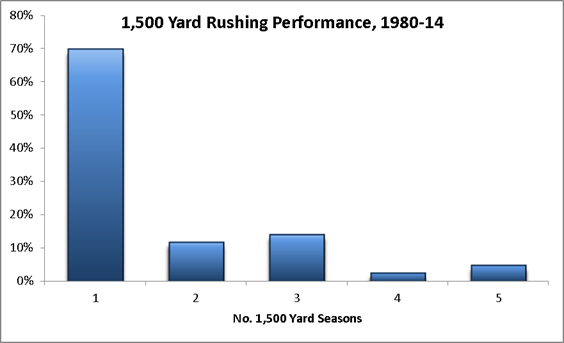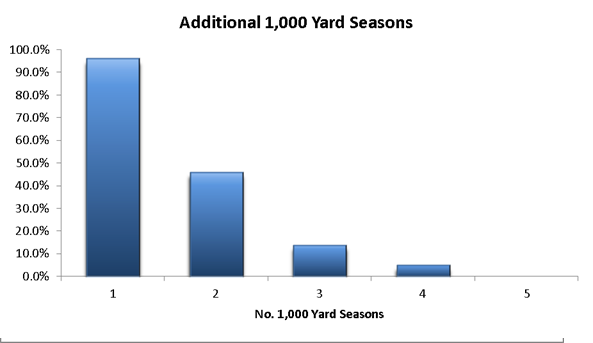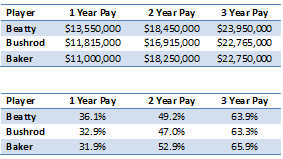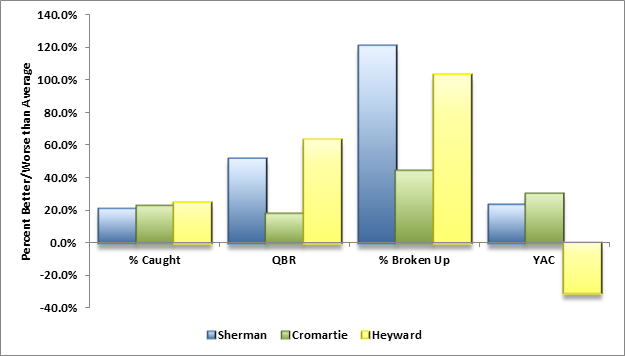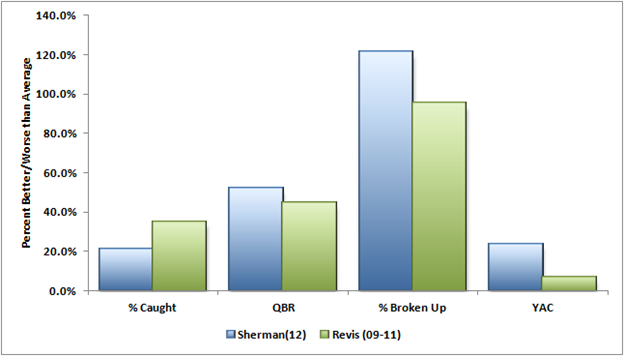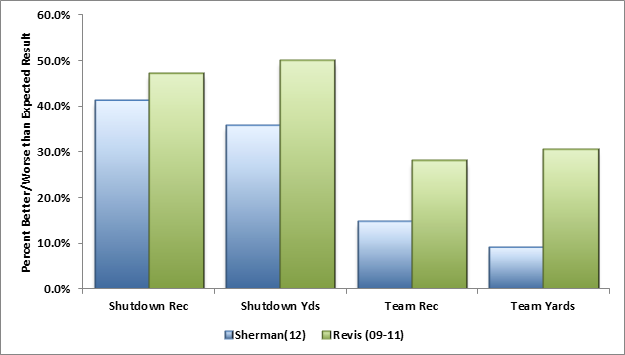The Dallas Cowboys will have an interesting contractual decision on their hands with running back DeMarco Murray. Murray is on pace for a 2,000 yard season, a feat just 6 players have accomplished since 1980. He has become the focal point of a Cowboys offense that has become a throwback to the decade where teams featured one running back and the offense flowed through that player. Set to be a free agent the question is how should the Cowboys approach the contract.
The Running Back Market
There is really only one massive contract for running backs, the contract for Adrian Peterson which averages just over $14 million a season. Prior to receiving that contract Peterson’s top season saw him run for 1,760 yards and he had run for no less than 1,298 yards in a season. Former Titans’ running back Chris Johnson had maxed out at 2,006 yards which also led to a contract worth around $14 million a season. Johnson was released this past year and its likely Peterson will be released following this season.
The secondary tier begins with LeSean McCoy of the Eagles at $9 million a season. McCoy earned his deal following a 1,300 yard season that he combined with contributions in the passing game. Arian Foster earned a similar number based on a 1,600 yard season at the age of 24. Matt Forte ranks third in the tier with $7.6 million a year, bringing an all around game to the table. His max rushing yardage was just over 1,200 yards but he was also consistently adding around 500 receiving yards a season.
Free agency has not been kind to runners who hit the market in the last two years. Chris Johnson and Steven Jackson topped the list at $4 million a season. Those players were considered proven commodities, but with a lot of wear and tear on their bodies. Those figures were nearly matched by completely unproven players Toby Gerhart and Donald Brown at $3.5 million a season.
With Johnson’s big contract void and Peterson’s soon to be, those two data points should be essentially useless for Murray. The secondary tier will likely shrink considerably this offseason as almost every one of those players could be a cap casualty following the season. The Chiefs and Seahawks did give moderate extensions to Jamaal Charles and Marshawn Lynch to make certain they reported to training camp, but neither contract indicated a long term commitment to either player. Most likely that will be the tier that Murray will look to fit into with the Cowboys.
The question the Cowboys need to ask is should he fit there?
Is Murray’s Dominance Sustainable?
It’s easy to look at Murray’s numbers and say you have to pay him because the risk of losing him is too great and if he goes the offense may go with him. Thus you simply pay him more than the highest paid player, McCoy, at the position. But when you make statements like that you have to try to gain a better understanding of what Murray is expected to do in the future, rather than overpaying for the present.
The reason many teams began to shift away from the runner dependent systems was because of the inability to sustain the big numbers they were put up at a young age. Millions of dollars would be invested in a player only to have the player’s production rapidly fall off a cliff with no possible out for the team due to the cap charges associated with releasing the player.
There are 43 players who began careers in the NFL after 1980 who posted seasons of more than 1,500 rushing yards and continued to play football (Robert Smith retired following his big season). 13 of those players produced a second season of at least 1,500 yards (Arian Foster is could be number 14 this season if his body can hold up). So it would be fair to say that a back that produces 1,500 yards has around a 30% chance of doing it again. Just 8 of the players produced at least a third 1,500 yard season. Here is the breakdown of 1,500 yard rushers’ future performance.
However, there is another factor that should be considered here and that is age. Many of the players on this list produced many of their dominant seasons in their early 20’s. Murray is already 26 years old. Just 10 players had a second season of 1,500 yards at the age of 27 or older. The only players to have at least a third 1,500 yard season at those ages were Barry Sanders and Tiki Barber. Eric Dickerson was on pace for that type of year in the strike-shortened “scab” season.
There were 21 players in the NFL that had their first 1,500 yard season when they were 26 or older. Of those players just 5 did it again. Those players were Curtis Martin, Larry Johnson, Priest Holmes, Tiki Barber, and Shaun Alexander. I think when you factor age into play you would consider a 23% chance of hitting the 1,500 yard mark one more time and a very small chance (less than 5%) of getting there a third time.
How Many Good Seasons Should Dallas Expect?
For the purpose of this discussion I’ll adjust the 2014 stats and the strike seasons to represent a 16 game season. While we can look at the entire list of 43 players, I think we are better off filtering it down to players who are more representative of Murray’s age. I want to look at players whose first 1,500 yard season came between the ages of 25 and 28 and we want to see how they performed over the next five years of their careers. The reason for the five year period is because this should be the maximum contract length given to any player in the NFL that is not a quarterback.
I think most people have always considered a good season by a running back to be 1,000 or more rushing yards. We can pretty much bank on Murray having at least one season of 1,000 or more yards. Of the group the only player to not gain 1,000 yards at some point after their first 1,500 yard season was Maurice Jones-Drew (McCoy is on pace to do so this season).
Getting a second 1,000 yard season might be more difficult. Of the 24 names who have had a second shot at 1,000 yards only 11 actually produced them. So there is less than a 50% chance that we can plan on Murray being able to give us two years of 1,000 yard production.
It gets bleaker after that. If we look at three years of 1,000 yard production we get Curtis Martin and Fred Taylor. Martin joined the 1,500 yard club when he was 28 years old while Taylor did it at 27. The only player to produce 1,000 yards four times after attaining his first 1,500 yard season in his mid 20’s was Jerome Bettis of the Pittsburgh Steelers. Bettis was a plodder of a back and averaged around 3.8 yards per carry in most of those seasons. It is unlikely that any other team in the NFL would have given him the attempts needed to reach that number.
When can those seasons be expected?
This is also an important question because it gives us some idea of perhaps how best to structure a contract to build in our optimum exit points. Here is the performance breakdown of the set of players used above in the five years following their 1,500 yard season.
What this tells me is that if Murray is to have another great season it is most likely going to happen in 2015. There is a 40% chance that he is going to come in at over 1,200 yards(a majority of those seasons are over 1,300 yards) and a 68% chance I’ll get over 1,000 yards from him.
In 2016 and 2017 the odds begin to move out of Murray’s favor. We have around a 15% chance of the great season and around 40% chance of just having a good season. Most likely if he is to have a second 1,000 yard year it will come in 2016 with a decline in 2017.
2018 and 2019 are not years where we would really consider Murray an asset. The odds are strongly against another 1,000 yard season and the odds are strongly in the favor of producing less than 600 yards. At that age he could be unproductive or simply looking to retire from the wear and tear on his body.
Setting the Price
I want to work from the bottom up with Murray, so the first thing I want to do is determine how much I will guarantee him upon signing his contract. Based on the performance of past players I want to look at a 3 year value for Murray, which is going to equal the guarantee I offer him on a 5 year contract. The guarantee is the most important part of the deal because it will define much of the structure since I need to have years 4 and 5 be completely escapable with a reasonable dead money total.
For each tier of yardage I’ll set a price based on past salaries. Normally I would go in year by year and use different values(contract structures are often a waterfall with the largest payments coming in year 1 and gradual reductions throughout), but for illustration I will just use one value per yardage category.
I will value a 1,600 yard season at $14 million, which is the top of the market even though that may not exist anymore. The 1,200 yard season I will factor in at $10.5 million a year, representing a raise from the current McCoy/Foster 3 year value levels of $10M to account for the increase in salary cap. A 1,000 yard season I’ll consider being worth $5 million, based on the Johnson and Jackson deals and between 800 and 999 yards being worth $3.5 million, which is around what teams will pay for the lower level talent. The next category has limited benefit so we will call that $1.5 million and for less than 400 yards I will only use $450,000, the average cost of a rookie the next three years.
If we multiply each percentage by the salary we get the following chart:
$14.5 million is what I would call my reasonable price to guarantee Murray based on my three year expectation level. I feel like I should be ok with that figure given the projected performance. That number alone is not going to get a contract done which is why I would only use it to set my guarantee. In general a full guarantee at the position should represent about 46% of the total contract value. So my offer to Murray is going to need to be somewhere in the vicinity of $31.5 million over 5 years.
If I factor in the 2018 and 2019 seasons I can bring my guarantee up to about $16.5 million. I would raise the amount guaranteed at that point to 48% and call it a $35 million contract. So I would be working between $31.5 and $35 million over 5 years. I would not go over that under any circumstance, and really anything above the $31 million I would probably walk away from. I’d likely consider 70% of the three year value to be guaranteed and I would raise that to 75% if I elected for the higher contract value, which is similar to what the Bears did with Forte a few years ago.
There are tons of cap possibilities with the contract depending on tolerance for cap hits in 2015 and 2016 versus the expected release date of 2017 and virtually guaranteed release date of 2018. Here would be a potential structure of the $31.5 million contract:
In this contract Murray receives a $5 million signing bonus, fully guaranteed 2015 salary and a partially guaranteed salary in 2016. In 2017 the cost to walk away is low enough that I can do that if necessary. My hope in the contract is that we can get two good seasons out of Murray. If I get one 1,200 yard season (preferably in 2015) and then a 1,000 yard year the following season I pretty much made my money back. I can then choose to chase a dream in 2017 or just release him.
The other course of action is to simply apply the franchise tag to Murray next year. The franchise tag will probably be in the ballpark of $10.5 million, which is similar to the cash value I had above in the first contract year. While that may be overpaying, I know that the best chance I have with him for another strong year is in 2015. He has a 40% chance of 1,200 or more yards and that is worth the salary if he gets there.
The important thing with the tag is I make no long term commitment to Murray if I use it. If he does great then I get value. If he flounders I can negotiate a deal on my terms or just let him walk. Because of the way the position breaks down, the team will almost always have leverage negotiating with a running back. The longer I push off that contract the better off I can be. I don’t think the tag is unreasonable in this case especially if his camp refuses to budge off a $9 million or so a year annual value, even if its unlikely to be found in free agency.
The Importance of the Contract
I find this contract to be a very important one to the future of the position. Most of the current contracts in that $7-9 million dollar range will be gone next year. It would not be shocking if the only player remaining in that tier is Jonathan Stewart of the Panthers who signed a ridiculous contract a few years back. If a 2,000 yard runner can’t break through and push past that figure it really means a very negative outlook on the position over the next 4 years. The running backs really need Murray to somehow break the bank on this contract even though there is no logical reason for the Cowboys or any other team to do that.
Most like the position needs younger entrants in the draft if it is to financially bounce back. They need the 21 year old underclassman to enter the draft, ala Clinton Portis a few years back, and reach that potential right out of the gates. At the most they would be 25 when getting a new contract and most likely just 24. Teams might give in more in those situations than they are now.
The only player on the horizon right now who could fit that bill is Le’Veon Bell of the Steelers. While he did not come out with the monster year he is on pace for close to 1,500 yards this season. He is just 22 years old. If the Steelers can keep him going and limit the amount they use LeGarrette Blount, Bell can be the guy after the 2015/16 season to try to re-ignite the position. But that will be infinitely harder if he is working off lower rather than higher numbers set by Murray.
